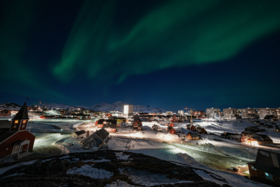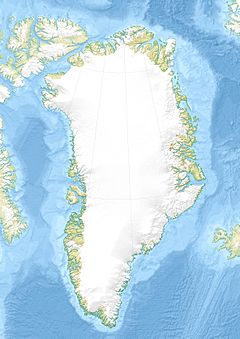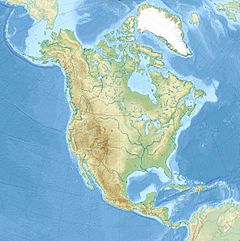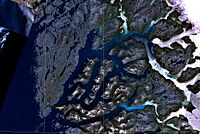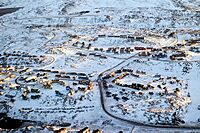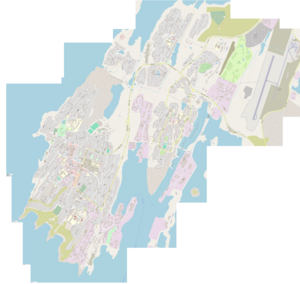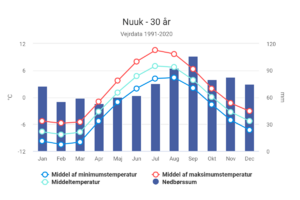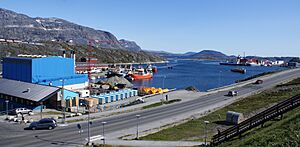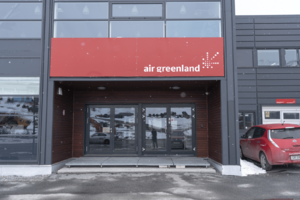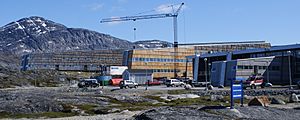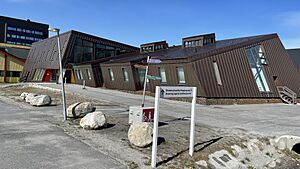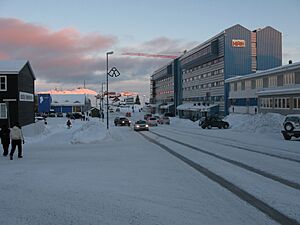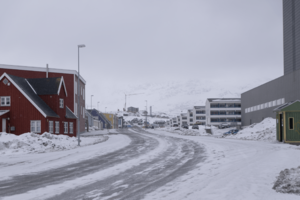Nuuk facts for kids
Quick facts for kids
Nuuk
|
|||
|---|---|---|---|
|
(left to right, top to bottom:) Skyline at night; Church; Downtown Nuuk, with Katuaq in the foreground; Sermitsiaq mountain overlooking Nuussuaq; Nuussuaq district; Qernertunnguit, neighbourhood in the Quassussuup Tungaa district; the skyline at night with the aurora borealis above
|
|||
|
|||
| Sovereign state | |||
| Constituent country | |||
| Municipality | Sermersooq | ||
| Founded | 29 August 1728 | ||
| Incorporated | 1728 | ||
| Area | |||
| • Total | 49 km2 (18.8 sq mi) | ||
| Elevation | 5 m (16 ft) | ||
| Population
(2024)
|
|||
| • Total | 19,872 (Largest in Greenland) | ||
| Demonym(s) | Nuummioq | ||
| Time zone | UTC−02:00 (Western Greenland Time) | ||
| • Summer (DST) | UTC−01:00 (Western Greenland Summer Time) | ||
| Postal code |
3900, 3905
|
||
Nuuk (pronounced "nook") is the capital city of Greenland. It is also the largest and most populated city in this self-governing territory, which is part of the Kingdom of Denmark. Nuuk is the main center for government, culture, and business in Greenland.
The city was started in 1728 by a missionary named Hans Egede from Denmark-Norway. He moved his earlier settlement, called Hope Colony, to this new spot. The new place was built at an Inuit settlement called Nûk and was first named Godthåb, which means "Good Hope."
The name "Nuuk" comes from the Greenlandic language and means "cape" or "headland." This name fits well because the city is located at the end of the Nuup Kangerlua fjord, right on the eastern coast of the Labrador Sea. Nuuk is known for being the northernmost capital city in the world. It is only a few kilometers further north than Reykjavík, the capital of Iceland.
When Greenland gained more self-rule in 1979, they decided to use Greenlandic names instead of Danish ones. That's when Godthåb officially became Nuuk. Today, about one-third of Greenland's entire population lives in Nuuk. The city has grown a lot since the 1950s and is now a modern place.
Nuuk gets its electricity from a special power plant called Buksefjord hydroelectric power plant. This plant uses renewable energy from water. The power travels to Nuuk through a very long power line that crosses the Ameralik fjord. This power line is the longest of its kind in the world!
Nuuk's Long History
The area where Nuuk is located has been home to people for a very long time. The first people to live here were the ancient Paleo-Eskimo people of the Saqqaq culture. They lived around 2200 BC near a place called Qoornoq. Later, the Dorset culture lived here, but they disappeared before the year 1000 AD.
Around 1000 AD, Norsemen (Vikings) settled in the Nuuk area. They lived here for about 400 years before their settlements disappeared for unknown reasons in the 15th century.
Founding the City
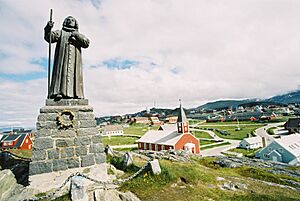
The city we know today was officially founded in 1728. It was first called Godt-Haab. This happened when the royal governor, Claus Paarss, moved Hans Egede's earlier colony from an island to the mainland. At that time, Greenland was part of Norway, which was united with Denmark.
Many of the first colonists got sick and died in the first year. In 1733 and 1734, a smallpox disease spread and killed many of the native people and Egede's wife. Hans Egede returned to Denmark in 1736, and his son, Poul, continued his work.
Godthåb became the main city for the Danish colony in South Greenland. Later, in 1940, it became the capital for all of Greenland.
Moravian Missionaries and Local Culture
In 1733, a group called the Moravian missionaries came to Greenland. They built a mission house in 1747, which they called New Herrnhut. Many Greenlanders moved to live near this mission station.
Around 1850, life was hard for many Greenlanders. European culture had changed their way of life, and many were struggling. In 1853, Hinrich Johannes Rink came to Greenland. He saw that the local Greenlandic culture was being lost. To help, he started Greenland's first newspaper in 1861, called Atuagagdliutt. This newspaper was based in Nuuk and became very important for Greenlandic identity.
Modern Nuuk
During World War II, Greenlanders felt a stronger sense of their own national identity. The use of the Greenlandic language grew. In 1979, the city of Godthåb was officially renamed Nuuk by the Greenland Home Rule government.
The city grew rapidly in the 1950s as Denmark helped modernize Greenland. Today, Nuuk is home to both Inuit people (the native people of Greenland) and Danes. More than one-third of Greenland's total population lives in the Nuuk area. Nuuk is considered one of the most "indigenous" cities in the world because such a large percentage of its people are Inuit, and the city strongly celebrates Inuit culture and history.
Nuuk's Location and Landscape
Nuuk is located on the southwest coast of Greenland. It sits at the mouth of the Nuup Kangerlua fjord, about 10 kilometers (6 miles) from the Labrador Sea. The city is about 240 kilometers (150 miles) south of the Arctic Circle.
The fjord near Nuuk is very wide and has many small islands. You can see the large mountain Sermitsiaq from almost anywhere in Nuuk. It is about 1,210 meters (3,970 feet) tall. This mountain even gave its name to Greenland's national newspaper, Sermitsiaq. Closer to the city are the peaks of Store Malene (790 meters/2,590 feet) and Lille Malene (420 meters/1,380 feet).
Nuuk's Climate
Nuuk has a tundra climate, which means it has long, cold, and snowy winters. The summers are short and cool. Even though it's cold, Nuuk's winters are milder than many other tundra areas, like parts of Alaska.
In winter, on December 21st (the shortest day), the sun rises late and sets early. In summer, on June 21st (the longest day), the sun rises very early and sets very late. This means there are many hours of daylight, almost like constant twilight!
Nuuk can have surprisingly mild temperatures sometimes, even in winter. The warmest month is July, with an average temperature of about 7.4°C (45.3°F). It doesn't get warm enough for many trees to grow naturally, but some planted trees do exist.
Nuuk's Population
With 19,872 people as of January 2024, Nuuk is by far the largest town in Greenland. The population of Nuuk has more than doubled since 1977. It has grown by almost 21% since the year 2000.
Many people from outside Greenland have moved to Nuuk for good job opportunities. In 2015, over 3,800 people living in Nuuk were born outside Greenland. Nuuk has the highest number of Danes compared to any other town in Greenland. About half of all immigrants in Greenland live in Nuuk.
Nuuk's Economy
Even though Nuuk is a small city, it has a strong economy with trade, business, and shipping. It started as a small fishing village. However, as the economy grew in the 1970s and 1980s, fishing became less important in the capital.
Still, the port is home to almost half of Greenland's fishing boats. A local company, Royal Greenland, processes a lot of seafood. This includes shrimp, cod, and halibut. Fresh seafood, including seal, is also sold at Nuuk's fish markets. The largest one is the Kalaaliaraq Market. Minerals like zinc and gold have also helped Nuuk's economy grow.
Nuuk, like most of Greenland, gets a lot of support from Denmark. This includes money to help fund its services.
Energy for Nuuk
All of Greenland's electricity comes from a government-owned company called Nukissiorfiit. Since 1993, Nuuk has received its power mainly from the Buksefjord hydroelectric power plant. This plant uses water to create clean energy. The power travels through a 5,376-meter (17,638-foot) long power line that crosses the Ameralik fjord. This is the longest single span for a power line in the world!
Education in Nuuk
Nuuk has several places for higher education. The University of Greenland (Ilisimatusarfik) is the only university in Greenland. It was founded in 1987. In 2007, a new building called Ilimmarfik was added. It has departments for journalism, business, languages, history, and more.
Nuuk is also home to the Department of Learning (Ilinniarfissuaq). This is the oldest educational building in Greenland. Other important schools include the Department of Nursing and Health Science, Nuuk Technical College, and the Iron & Metal School.
Healthcare in Nuuk
The city has the Queen Ingrid's Health Center. This center is the main health facility for the Sermersooq region. It has an emergency room and a clinic with many doctors. Nuuk also has the main hospital for all of Greenland, also called Queen Ingrid's Hospital.
Shopping and Tourism
The Nuuk Tourist Office was built in 1992. It is the main office for Greenland's National Tourist Board.
Nuuk has many shops where you can find local art and crafts. In July 2012, Greenland's first shopping mall, Nuuk Center (NC), opened. It even has Greenland's first underground parking. You can also find several supermarkets like Pisiffik, Brugseni, and Spar.
Getting Around Nuuk
Nuuk Airport
Nuuk has an international airport about 4 kilometers (2.5 miles) northeast of the city center. It was built in 1979. This airport is a main hub for Air Greenland, which is also based in Nuuk. There are flights within Greenland and to Iceland. Plans are being made to make the runway longer so that larger planes can fly directly to European cities like Denmark.
Starting in summer 2024, Air Greenland and Canadian North airlines will have weekly flights between Nuuk and Iqaluit, Canada.
Sea Travel
Because it's expensive to fly goods to Greenland, Nuuk and other towns get supplies by cargo ships from Denmark. These ships sail mainly during the warmer months when the winter ice has melted. They bring clothes, food, medicine, and machinery. They return with frozen shrimp and fish.
For most of the year, Nuuk also has a ferry service twice a week. This ferry, run by the Arctic Umiaq Line, connects towns along Greenland's western coast.
Roads in Nuuk
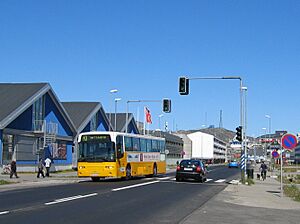
Most of the buses and cars in Greenland are in Nuuk. There are no roads that connect Nuuk to other towns in Greenland. The main street in Nuuk is Aqqusinersuaq. It has many shops and the 140-room Hotel Hans Egede.
Since 2009, a bus service called Nuup Bussii provides city transport in Nuuk. It connects the city center to the airport and different neighborhoods like Nuussuaq and Qinngorput. In 2012, the buses carried over 2 million passengers around Nuuk!
Nuuk's Buildings and Culture
Historic Buildings
- Hans Egede's House: This house was built in 1721 by the missionary Hans Egede. It is the oldest building in Greenland. It is now used for government events.
- Nuuk Cathedral: The Church of Our Saviour was built in 1849. Its red building with a clock tower is a famous sight. It became Nuuk Cathedral in 1994.
- Herrnhut House: This was the main building for the Moravian mission in Nuuk.
Modern Architecture
Nuuk also has many modern buildings. Some examples include:
- The Katuaq cultural center (built in 1997).
- The University of Greenland campus (built in 2008).
- The Nuuk Center shopping mall (built in 2012).
Cultural Spots
Katuaq is a cultural center. It hosts concerts, movies, art shows, and meetings. It has two large halls for performances. It also has an art school, a library, meeting rooms, and a café.
The Nuuk Art Museum is the only private art museum in Greenland. It has a great collection of local paintings, drawings, and prints. It also displays figures made from soapstone, ivory, and wood.
Libraries and Learning
Ilisimatusarfik, the University of Greenland, is in Nuuk. It is Greenland's national university. Most classes are taught in Danish, but some are in Kalaallisut (Greenlandic). In 2007, the university had about 150 students. Its library holds about 30,000 books.
The National Library of Greenland in Nuuk is the largest library in the country. It helps to keep Greenland's culture and history safe. The library's collection is split between the public library in the city center and the university campus.
Sports in Nuuk
Nuuk has several sports clubs, including Nuuk IL and B-67. The Nuuk Stadium is a large field used mostly for soccer games. It can hold 2,000 people. The stadium is also used for concerts; the rock band Nazareth once performed there!
Nuuk also has the Godthåbhallen, a stadium for handball. It is the home of the Greenland men's national handball team and can hold 1,000 people.
For winter sports, there is a hill for alpine skiing on the mountain Lille Malene. It has a height difference of about 300 meters (980 feet). Nuuk also has a golf course, which is the only one in the Arctic!
Famous People from Nuuk
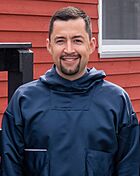
Many notable people have come from Nuuk, including:
- Hans Lynge (1906-1988), a writer, painter, and politician.
- Finn Lynge (1933–2014), a politician and activist for Indigenous rights.
- Agnethe Davidsen (1947–2007), Greenland's first female government minister.
- Rasmus Lyberth (born 1951), a musician and actor.
- Sofie Petersen (born 1955), a Lutheran bishop.
- Jesper Grønkjær (born 1977), a famous soccer player for Denmark.
- Múte Bourup Egede (born 1987), the current Prime Minister of Greenland.
Nuuk's Sister Cities
Nuuk has "twin towns" or "sister cities" around the world. These are cities that have special friendly relationships.
- Aalborg, Denmark (since 2002)
- Changchun, China
- Tiverton, Rhode Island, United States
- Lyngby-Taarbæk, Denmark
- Huddinge, Sweden
- Reykjavík, Iceland
- Ushuaia, Argentina
- Bocas Town, Panama
- Sorong, Indonesia
- Stockholm, Sweden
See also
 In Spanish: Nuuk para niños
In Spanish: Nuuk para niños








